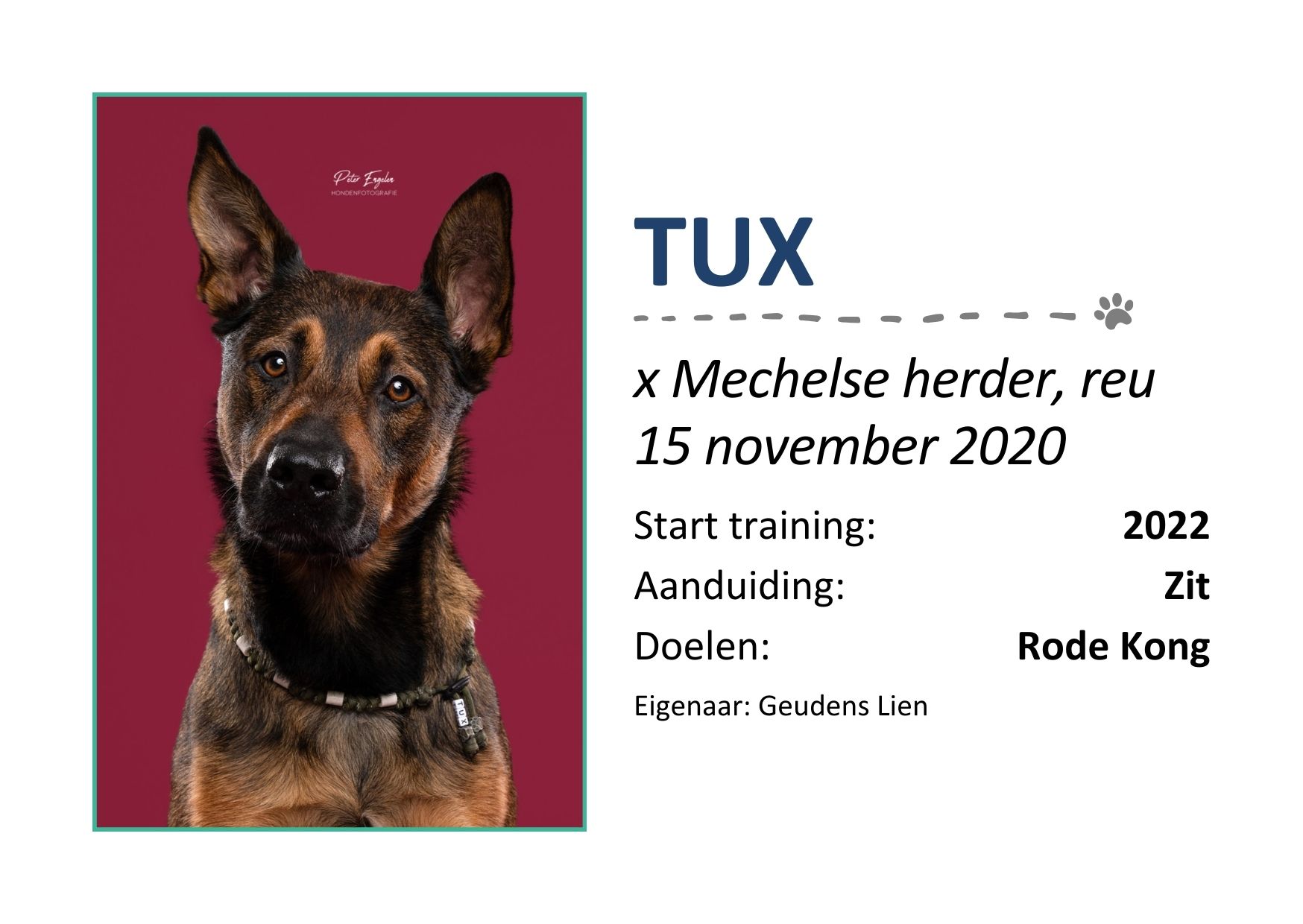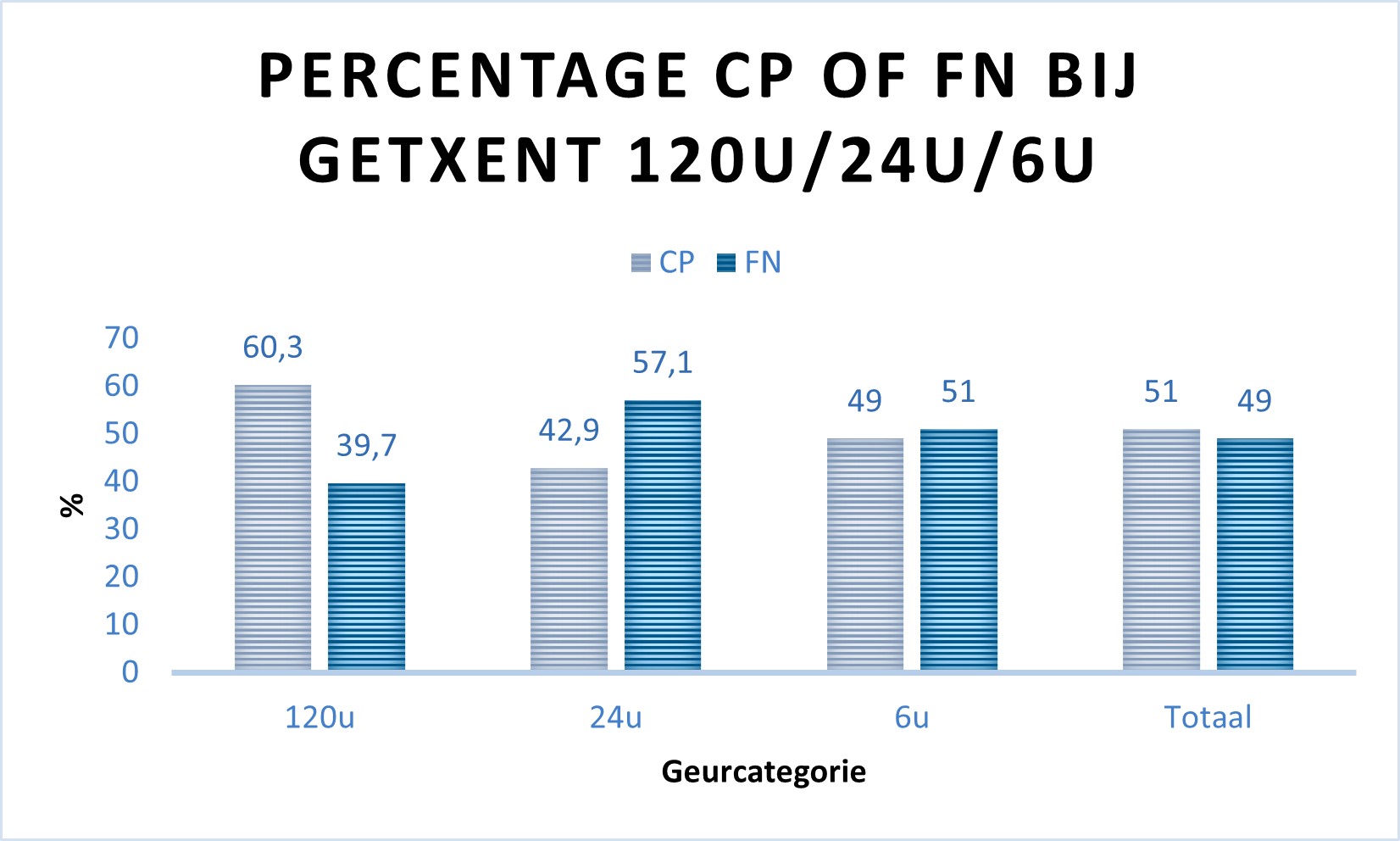Getxent: een veilige trainingsmethode voor zoekhonden zoals explosievenhonden?
“Is hij er echt helemaal klaar voor?”, vroeg Darko’s eigenaar en geleider aan hun trainer wanneer deze voor het eerst een opdracht met echte explosieven klaarzette voor hen. De trainer antwoordde: “We zullen erop moeten vertrouwen, hij heeft zijn volledige basisopleiding met succes afgerond. Nu is het tijd voor het echte werk.” Jammer genoeg bleek de basisopleiding voor Darko niet voldoende om de explosieven te detecteren. De noodzaak om te zoeken naar een uitbreiding van de training was duidelijk, maar hoe konden ze het aanpakken?
Aardbeien-chocoladetaart
Soms is de zoekgeur waarop zoekhonden worden getraind moeilijk te verkrijgen, te manipuleren of te transporteren. Een mogelijke oplossing hiervoor is het gebruikmaken van een geurdrager, een andere stof die de zoekgeur kan opnemen en opnieuw kan vrijgeven. Voorheen werd hiervoor gebruik gemaakt van stoffen zoals wattenstaafjes, wasspelden, …
Zoekhonden leren hierdoor te reageren op een zogenaamde ‘geurmix’ namelijk de effectieve zoekgeur én de geur van het wattenstaafje.
Beeld je eens in dat je mega fan bent van aardbeien-chocoladetaart. Zou jij dan even hard en even secuur reageren op de geur van enkel een aardbeiengeur dan wanneer je de combinatie chocolade en aardbeien zou ruiken?
Geurloze Getxent-tubes
De oplossing voor dit probleem zou het gebruik van Getxent-tubes als geurdrager kunnen zijn. Het grote voordeel van het gebruik van Getxent-tubes is de mogelijkheid om honden vanaf hun eerste training enkel bloot te stellen aan hun effectieve zoekgeur. Hiermee worden de honden onmiddellijk getraind op een aardbeiengeur of een chocadegeur en niet langer op de mix van aardbei en chocolade.
Toekomstperspectief?
Deze technologie zou veelbelovend kunnen zijn voor het optimaliseren van trainingsmethodes van detectiehonden, maar onderzoek naar de effectiviteit en accuraatheid waarmee Getxent-tubes kunnen worden ingezet als geurdragers is noodzakelijk.
 In een onderzoek waarbij getest werd of er een verschil is in snuffelduur tussen een met rode Kong (hondenspeeltje) geïmpregneerde Getxent-tube en een blanco Getxent of nevengeur blijkt dat de honden significant langer snuffelden aan de geïmpregneerde Getxents.
In een onderzoek waarbij getest werd of er een verschil is in snuffelduur tussen een met rode Kong (hondenspeeltje) geïmpregneerde Getxent-tube en een blanco Getxent of nevengeur blijkt dat de honden significant langer snuffelden aan de geïmpregneerde Getxents.

Wanneer Getxent-tubes met een verschillende impregnatieduur gebruikt werden, toonden de honden toonden geen verschil in snuffelduur, maar was het hoogste percentage correcte aanduidingen te zien bij de langste impregnatieduur van 120u. Het Getxent-bedrijf stelt dat een langere impregnatieduur samenhangt met een sterker geurbeeld. Een voldoende lange impregnatieduur kan een belangrijke factor zijn om rekening mee te houden.
Ondanks het feit dat sommige honden de Kong-geur effectief konden herkennen in de geïmpregneerde geurdragers werden tijdens de testen gedragingen waargenomen die doen vermoeden dat de honden niet altijd even zeker waren van de geur die ze roken. Mogelijk hebben de geïmpregneerde Getxent toch een andere geur, dan de originele geur.
Getxent-tubes als geurdrager gelijken voor een aantal honden voldoende op de originele geur waardoor ze in de toekomst effectief zouden kunnen bijdragen tot het verbeteren van detectietrainingen naar explosieven en andere targets.
Toch blijft enige voorzichtheid noodzakelijk aangezien dit niet voor alle honden van toepasing was.
Echter zouden deze tubes wel een grote vooruitgang kunnen bieden in het trainen van detectiehonden. Hiermee kunnen we niet alleen de trainingsmogelijkheden van drugs- of explosievenhonden vergroten, maar ook geurmonsters nemen van zieke of niet zieke patiënten om ook de trainingen rond detectie van bepaalde virussen, zoals met COVID-19 reeds is gedaan, of kanker verder te zetten.
Bibliografie
Abbot, B. E., Barwig, S., & Mays, A. (1986). The German Shepherd Book. Wheat Ridge: Hoflin Publishing.
Allouche, O., Tsoar, A., & Kadmon, R. (2006, december). Assessing the accuracy of species distribution models: prevalence, kappa and the true skill statistics (TSS). Journal of applied ecology, pp. 1223-1232. doi:https://doi.org/10.1111/j.1365-2664.2006.01214.x
Appell, L. (1970). Physical foundations in perfumery. American perfumer and cosmetics.
Aviles-Rosa, E. O., Nita, M., Feuerbacher, E., & Hall, N. (2023, Januari). An evaluation of Spotted Lanternfly (Lycorma delicatula) detection dog training and performance. Applied Animal Behaviour Science.
Beltz, K. (2013, Februari 2). The Development of Calibrants through Characterization of Volatile Organic Compounds from Peroxide Based Explosives and a Non-target Chemical Calibration Compound. Florida, Verenigde Staten: Florida International University.
Booth, S. (1998). Purely Positive Training: companion to competition. Unionville, NY: The Royal Fireworks Press.
Buck, L. B. (2004, november). Olfactory receptors and odor coding in mammals. Nutrition reviews, 62(3), pp. S184-S188. doi:https://doi.org/10.1111/j.1753-4887.2004.tb00097.x
Budras, K. D., Fricke, W., & McCarthy, P. H. (1994). Anatomy of the dog: an illustrated text. Institüt für Veterinär-Anatomie, Duitsland: Freie Universität.
Clern, R. (2022). Methodologies for training detection dogs and scent sample storing. Uppsala, Zweden: Swedish University of Agricultural Sciences.
Concha, A., Mills, D. S., Feugier, A., Zulch, H., Guest, C., Harris, R., & Pike, T. W. (2014, november). Using sniffing behavior to differentiate true negative from false negative responses in trained scent-detection dogs. Chemical senses, pp. 749-754. doi:https://doi.org/10.1093/chemse/bju045
Craven, B. A., Paterson, E. G., & Settles, G. S. (2010, juni 6). The fluid dynamics of canine olfaction: unique nasal airflow patterns as an explanation of macrosmia. Journal of the royal society interface, 7(47). doi:https://doi.org/10.1098/rsif.2009.0490
De Voogt, P., Puijker, L., Vink, C., & Van Wezel, A. (2009). Smaak- en geurdrempels van benzine additieven en voorkomen in. H20, 42(25/26), pp. 46-47. Opgehaald van https://pure.uva.nl/ws/files/894836/75725_315708.pdf
DeGreeff, L. E., Katilie, C. J., Sharpes, C. E., Maughan, M. N., Gadberry, J. D., Nolan, P. L., . . . Buckley, P. E. (2023, November 30). Evaluation of Non-Detonable Canine Training Aids for Explosives by Headspace Analysis and Canine Testing.
Divin, R., Sopko, B., Scucka, J., & Amler, E. (2018, December 31). Nanofiber scent carrier. Clinician and technology, pp. 123-130. Dorman, D. C., & Lazarowski, L. (2014, februari). Explosives detection by military working dogs: olfactory generalization from components to mixtures. Applied animal behaviour science, pp. 84-93.
Ehmann, R., Boedeker, E., Friedrich, U., Sagert, J., Dippon, J., Friedel, G., & Walles, T. (2012). Canine scent detection in the diagnosis of lung cancer: revisiting a puzzling phenomenon. European Respiratory Journal, pp. 669-676. doi:10.1183/09031936.00051711
Furton, K. G., & Myers, L. J. (2001). The scientific foundation and efficacy of the use of canines as chemical detectors for explosives. Talanta.
Gallegos, S. F. (2022). Odor signature evaluation: Perspectives encompassing explosives and pathogen detection. Texas: Texas Tech University.
Getxent. (2023, mei 6). How can I manipulatie Getxent tubes? Opgehaald van Getxent: https://getxent.com/a/docs/handling/how-can-i-manipulate-getxent-tubes&…;
Getxent. (2023, juli 24). How long can I use an impregnated Getxent tubes? Opgehaald van Getxent: https://getxent.com/a/docs/training/how-long-can-i-use-an-impregnated-g…;
Getxent. (2023, juli 11). How long do I need to impregnate Getxent tubes? Opgehaald van Getxent: https://getxent.com/a/docs/impregnation/how-long-do-i-need-to-impregnat…;
Getxent. (2023). Innovative technology for detection. Opgehaald van Getxent: https://getxent.com/ Getxent. (2024, januari 24). Can I use control tubes ("blanks")? Opgehaald van Getxent: https://getxent.com/a/docs/training/can-i-use-control-tubes-%22blanks%2…;
Guerrero-Flores, H., Apresa-Garcia, T., Garay-Villar, O., Sanchez-Perez, A., Flores-Villegas, D., Bandera-Calderon, A., . . . Badillo-Romero, J. (2017, Januari 26). A non-invasive tool for detecting cervical cancer odor by trained scent dogs. BMC Cancer.
Hall, N. J., Kelsey, G., Smith, D. W., & Wynne, C. D. (2015). Performance of Pugs, German Shepherds, and Greyhounds (Canis lupus familiaris) on an odor-discrimination task. Journal of Comparatice Psychology, pp. 237-246.
Hall, N., Smith, D. W., & Wynne, C. D. (2016, Mei). Effect of odorant pre-exposure on domestic dogs' sensitivity on an odorant detection task. Applied animal behaviour science, pp. 80-87.
Helton, W. S. (2009). Canine ergonomics: the science of working dogs. Boca Raton: CRC Press. doi:https://doi.org/10.1201/9781420079920
Herin, G. (2024, januari 12). Testing sniffing duration at Getxent tubes. (H. Vervaecke, Interviewer)
Hiby, E. F., Rooney, N. J., & Bradshaw, J. W. (2004, Februari). Dog training methods: their use, effectiveness and interaction with behaviour and welfare. Animal Welfare, 2004(1), pp. 63 69. doi:https://doi.org/10.1017/S0962728600026683
Horvath, G., Andersson, H., & Paulsson, G. (2010, November 24). Charasteristic odour in the blood reveals ovarian cancer. BMC Cancer. doi:10.1186/1471-2407-10-643
Hoyer-Tomiczek, U., Sauseng, G., & Hoch, G. (2016, april). Scent detection dogs for the Asian longhorn beetle, Anoplophora glabripennis. OEPP, pp. 148-155. doi:https://doi.org/10.1111/epp.12282
Hubbard, J. W. (2021, April 15). Detectives, Detectors, and Drug Sniffers: Institutionalizing the Drug Dog Before and After Counterinsurgency. The Social History of Alcohol and Drugs.
Jamieson, L. T., Baxter, G. S., & Murray, P. J. (2017, Oktober). Identifying suitable detection dogs. Applied Animal Behaviour Science, pp. 1-7. doi:https://doi.org/10.1016/j.applanim.2017.06.010
Jezierski, T., Sobcynska, M., Walczak, M., Gorecka-Bruzda, A., & Ensminger, J. (2012, januari 11). Do trained dogs discriminate individual body odors of women better then those of men? Journal of forensic sciences, 57(3), pp. 647-653. doi:https://doi.org/10.1111/j.1556 4029.2011.02029.x
Johnen, D. H., & Fischer-Tenhagen, C. (2013, oktober). Canine scent detection - fact of fiction? Applied animal behaviour science, 148(3-4), pp. 201-208. doi:https://doi.org/10.1016/j.applanim.2013.09.002
Jones, K. E., Dashfield, K., Downend, A. B., & Otto, C. M. (2004, September 6). Search- and rescue dogs: an overview for veterinarians. Vet Med Today: Disaster Medicine, pp. 854-860.
Jones, P. (2006, April). Scents and sense-ability. Forensic Magazine.
Kane, S. A., Aviles-Rosa, E. O., & Hall, N. J. (2023, September). Development and assessment of Spotted Lanternfly (Lycorma delicatula) training aids for detection canines. Applied Animal Behaviour Science.
Keep, B., Pike, T. W., Zulch, H. E., Ratcliffe, V. F., Porritt, F., Hobbs, E., & Wilkinson, A. (2021, maart). The impact of training method on odour learning and generalisation in detection animals. Applied animal behaviour science, 236, pp. 105-266. doi:https://doi.org/10.1016/j.applanim.2021.105266
Kokocinska-Kusiak, A., Woszczylo, M., Zybala, M., Maciocha, J., Barlowska, K., & Dzieciot, M. (2021, augustus). Canine olfactions: psychology, behavior and possibilities for practical applications. Animals, 11(8), p. 2463. doi:https://doi.org/10.3390/ani11082463 KONG Company. (2024). KONG Klassiek. Opgehaald van kongcompany.com: https://www.kongcompany.com/nl/catalogue/KK/
Kranz, W. D., Strange, N. A., & Goodpaster, J. V. (2014, November 26). “Fooling fido”—chemical and behavioral studies of pseudo-explosive canine training aids. Analytical and Bioanalytical Chemistry, pp. 7817-7825.
Lazarowski, L., Waggoner, L. P., Kirchbaum, S., Singletary, M., Haney, P., Rogers, B., & Angle, C. (2020, september 2). Selecting Dogs for Explosives Detection: Behavioural Charasteristics. Veterinary Science. doi:https://doi.org/10.3389/fvets.2020.00597
MacCrehan, W., Moore, S., & Schantz, M. (2012, Juni 29). Reproducible vapor-time profiles using solid-phase microextraction with an externally sampled internal standard. J Chromatogr A., pp. 28-36.
Marville, O. (2023). Kunnen we met sensoren de snuffelduur meten bij zoekhonden? Sint-Niklaas, Oost-Vlaanderen, België: Odisee: de co-hogeschool.
Maughan, M. N., Best, E. M., Gadberry, J. D., Sharpes, C. E., Evans, K. L., Chue, C. C., . . . Buckles, P. E. (2022, April 4). The Use and Potential of Biomedical Detection Dogs During a Disease Outbreak. Frontiers. doi:https://doi.org/10.3389/fmed.2022.848090
McKeague, B., & Finlay, C. (2024, februari). Conservation detection dogs: A critical review of efficacy and methodology. Ecology and Evolution. doi:https://doi.org/10.1002/ece3.10866
Mehrkam, L. R., & Wynne, C. D. (2014, Juni). Behavioral differences among breeds of domestic dogs (Canis lupus familiaris): Current status of the science. Aplied Animal Behaviour Science, pp. 12-27. doi:https://doi.org/10.1016/j.applanim.2014.03.005
Miller, P. (2008). The Power of Positive Dog Training. Canada: Howell Books.
Mori, K., Nagao, H., & Yoshihara, Y. (1999, oktober 22). The olfactory bulb: coding and processing of odor molecule information. Science, pp. 711-715. doi:DOI: 10.1126/science.286.5440.711
Moser, A. Y., Bizo, L., & Brown, W. Y. (2019, September 19). Olfactory generalization in detector dogs. Animals.
Mouton, A., Bird, D., Li, G., Craven, B. A., Levine, J. M., Morselli, M., . . . Murphy, W. J. (2024). Genetic and anatomical determinants of olfaction in dogs and wild canids. bioRxiv, 2024(4). doi:https://doi.org/10.1101/2024.04.15.589487
Neuhaus, W. (1953, november). Uber die Riechschärfe des Hundes für Fettsäuren. Comparative Physiology, 35, pp. 527-552. doi:https://doi.org/10.1007/BF00350805
Nizio, K. D., Ueland, M., Stuart, B. H., & Forbes, S. L. (2017, September). The analysis of textiles associated with decomposing remains as a natural training aid for cadaver-detection dogs. Forensic Chemistry, pp. 33-45.
NPA Global Training Center. (2004). Drive and motivation training. In Training of Mine Detection Dogs in Bosnia and Herzegovina (pp. 32-38). Genève: GICHD.
Odisee. (2023). SnuffelSensor. Opgehaald van Zoekdieren: https://zoekdieren.odisee.be/snuffelsensor
Oldenburg, C., Schoon, A., & Heitkönig, I. M. (2016, Mei-Juni). Wildlife detection dog training: A case study on achieving generalization between target odor variations while retaining specificity. Journal of Veterinary Behaviour, pp. 34-38.
Oxley, J. C., Smith, J. L., Moran, J., Nelson, K., & Utley, W. E. (2004). Training dogs to detect Triacetone Triperoxide (TATP). Defense and Security. Orlando, Florida, Verenigde Staten: Society of Photo-Optical Instrumentation Engineers (SPIE).
Parr-Cortes, Z., Müller, C. T., Talas, L., Mendl, M., Guest, C., & Rooney, N. J. (2024, april). Does the odour of human stress or relaxation affect dogs' cognitive bias? University of Bristol. doi:https://doi.org/10.21203/rs.3.rs-4142530/v1
Penton, V. (1992). The use of dogs in search, rescue and recovery. Journal of Wilderness Medicine, pp. 292-300.
Pirrone, F., Piotti, P., Galli, M., Gasparri, R., La Spina, A., Spaggiari, L., & Albertini, M. (2023, Maart 5). Sniffer dogs performance is stable over time in detecting COVID-19 positive samples and agrees with the rapid antigen test in the field. Scientific reports. doi:https://doi.org/10.1038/s41598-023-30897-1
Plate, K., Whitehead, A., Bunker, P., DeShon, D. L., Barnes, M. A., & Hall, N. (2022). Advancing early detection technologies for dreissenid mussel invasion: comparing detection of Dreissena polymorpha in environmental samples with environmental DNA (eDNA) and scent detection canines . Texas: Texas Tech University.
Rebmann, A., David, E., & Sorg, M. H. (2000). Cadaver dog handbook. New Yotk: CRC Press.
Riach, A. C., Asqquith, R., & Fallon, M. L. (2017, september). Length of time domestic dogs (Canis familiaris) spend smelling urine of gonadectomised and intact censpecifics. Behavioural Processes, 142, pp. 138-140. doi:https://doi.org/10.1016/j.beproc.2017.06.009
Scheffers, T., Maas, J., Siegert, H., & Wielaard, P. (2009). Dossier vluctige organische stoffen. Arbokennis ontsloten, Nederland. Schmelzer, B. (2009, april 10). Geur en smaak, de ongekende zintuigen.
Schoon, A. (2024). De oorsprong van de 'KONG' methode. KNPV, pp. 26-29.
Schoon, A., Fjellanger, R., Kjeldsen, M., & Goss, K. U. (2014, April). Using dogs to detect hidden corrosion. Applied Animal Behaviour Science, pp. 43-52.
Schoon, G. A., De Jonge, D., & Hilverink, P. (2020, Januari-februari). How dogs learn to detect colon cancer - Optimizing the use of training aids. Journal of Veterinary Behaviour, pp. 38-44.
Settles, G. S., Kester, D. A., & Dodson-Dreibelbis, L. J. (2003). The external aerodynamics of canine olfaction. Sensors and sensing in biology and engineering, pp. 323-335. doi:https://doi.org/10.1007/978-3-7091-6025-1_23
Simeon-Dubach, D., Chaber, A., Alvergnat, G., Grandejean, D., Mardones, F. O., & Volk, H. A. (2023, September 5). State of art, opportunities and challenges in the use of medical detection dogs in the laboratory and in the field. Frontiers.
Simon, A. G. (2022, September). Analysis of non-hazardous canine training aids for triacetone triperoxide (TATP). Forensic Chemistry. doi:https://doi.org/10.1016/j.forc.2022.100440
Simon, A., Lazarowski, L., Singletary, M., Barrow, J., Van Arsdale, K., Angle, T., . . . Giles, K. (2020, Juni 5). A review of the types of training aids used for canine detection training. Frontiers Veterinary Science.
Skinner, B. (1953). Science and human behavior. Verenigde Staten: The free press.
Smith, D. W., Hall, N. J., & Wynne, C. D. (2014, Januari 24). Effect of odor preexposure on acquisition of an odor discrimination in dogs. Learning & behaviour, pp. 144-152.
Soggiu, F., Sabbatinelli, J., Giuliani, A., Benedetti, R., Marchegiani, A., Sgarangella, F., . . . Rippo, M. R. (2023, April 25). Sensitivity and specificity of in vivo COVID-19 screening by detection dogs: Results of the C19-Screendog multicenter study. Heliyon. Opgehaald van https://www.cell.com/heliyon/fulltext/S2405-8440(23)02847 5?_returnURL=https%3A%2F%2Flinkinghub.elsevier.com%2Fretrieve%2Fpii%2FS2405844023 028475%3Fshowall%3Dtrue
Suma, P., La Pergola, A., Longo, S., & Soroker, V. (2013, augustus 14). The use of sniffing dogs for the detection of Rhynchophorus ferrugineus. Phytoparasitica, pp. 269-274. Opgehaald van https://link.springer.com/article/10.1007/s12600-013-0330-0
Van Dam, A., Schoon, A., Wierda, S. F., Heeringa, E., & Aalders, M. C. (2019, September). The use of crime scene detection dogs to locate semen stains on different types of fabric. Forensic Science International.
Van Der Hammen, L. (1974). Aanvullende gegevens over geuren, de reuk en de geurbeschrijvinga. De Levende Natuur, 9, pp. 196-203. Opgeroepen op februari 20, 2024, van https://natuurtijdschriften.nl/pub/494125/DLN0771962039.pdf
Vervaecke, H., Van Krunkelsven, E., & Van Den Berg, K. (2021). Training of ecological detection dogs fot wolf scat. Opgehaald van https://zoekdieren.odisee.be/sites/default/files/public/2022 04/Vervaecke%20et%20al%202021%20Wolf%20scat.pdf
Vorstenbosch, A. (2023). Snuffelduur bij zoekhonden. Odisee campus Sint-Niklaas.
Walczak, M., Jezierski, T., & Gorecka, A. (2008). Information-seeking behaviour of sniffer dogs during match-to-sample training in scent lineup. Polish Psychological bulletin, 39(2), pp. 71-80. doi:10.2478/v10059-008-0010-y
Weakley-Jones, B., DeGreeff, L. E., & Furton, K. G. (2012, April 10). Creation of training aids for human remains detection canines utilizing a non-contact, dynamic airflow volatile concentration technique. Forensic Science International, pp. 32-38.













